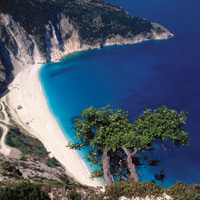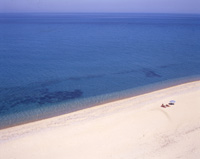 The magnificent sights, amazing beaches, rich cultural heritage, great monuments, mountains, castles, remote monasteries and cheerful, hospitable people are the treasures making Kefalonia one of the most attractive destinations.
The magnificent sights, amazing beaches, rich cultural heritage, great monuments, mountains, castles, remote monasteries and cheerful, hospitable people are the treasures making Kefalonia one of the most attractive destinations.

It is the biggest island of the Ionian Sea, at the outlet of Patraikos Bay, between Zante and Lefkada. It stretches over an area of 904 km2 with a coastline length of 250 km.
The island has a splendid natural beauty and a diversified geological structure with innumerable small bays and rich vegetation; the mountain Aenos (National Park since 1962 supporting rich flora and fauna) looks impressive from far away.
During the Byzantine period Kefalonia formed part of the province of Achaia and the prefecture of East Illyria. It was conquered by the Normans, the Franks, the Venetians and the Turks.
It joined the rest of Greece along with the other Ionian Islands, on May 21st, 1864. The inhabitants’ resistance against the Italians and the Germans during World War II was considerable.
The movie ‘’Captain Corelli’s Mandolin’’ shot in the natural scenery of the island refers to a history of the Resistance movement.
On foot - Argostoli
Argostoli is the island capital (as well as the capital of Kefalonia and Ithaca prefecture) since 1757. It is a modern town, which preserves its traditional character, built amphitheatrically with a view of the Koutavous lagoon, which is a crossing area for the migratory birds. The city has many neoclassical buildings, big squares, churches and remarkable cultural activity.
What to see in Argostoli:

The Archaeological Museum exhibiting important findings discovered in the whole island, mainly dating back to the Mycenaean period.
The Korgialeneios Library, one of the biggest libraries in Greece, housing more than 55,000 volumes and a great collection of Byzantine icons.
The Folklore and History Museum. It hosts exhibits associated with the history of the island (costumes, weapons, heirlooms etc.) and many every-day life objects.- The central and spacious Valianos square with the statue of the benefactor P. Vallianos, many cafes, restaurants and bars.
The Napier Garden. It was named after the British Governor Napier, who in the middle of the 19th century realized many infrastructure projects on the island and despite its limited space has a variety of trees.
The Rizospaston street, with palm trees and the monument to radical revolutionaries.
Lithostroto, the central street of the town, with commercial stores and many meeting points for young people.
The Kampanas square situated in the middle of the Lithostroto, with the belfry bearing the same name (recently renovated according to the plans of the original tower which collapsed during the earthquakes of 1953), offering an amazing view of the town and the Koutavou Lagoon.
The 900 meter long Drapano stone bridge (or Devoset bridge) built by the English in 1813 in order to connect Argostoli to the opposite coast. - The coastal Public Market - where you will find the bust of the Kefalonian poet Nikos Kavadias. - The “Farao” Hill offering a panoramic view to the town.
The Katavothres, which are situated near the lighthouse of Aghioi Theodoroi. These are caves, where the sea waters enter and pass through them reaching Sami at the other side of the island after a 14 day journey .- The Aghioi Theodoroi lighthouse at the end of the peninsula of Lassi, where the sunset is majestic.- The “Giro of Lassi”, a seaside road which leads from the town to Lassi.- The “Vinaries Wine Storehouse”, in “Thalassomylos”, hosting an exhibition of wine and local products.
Enos Forest
Kefalonia is the biggest Greek island in the area of the Ionian Sea and Mount Ainos is the highest mountain in the same area, with an altitude that surpasses 1,600 m. Mount Ainos is well known not only for its altitude but also due to its dense forest of Kefalonian fir trees (Abies cephalonica), which dominate at the upper altitudes.
This species is endemic to Greece and was described for the first time in the same region. In the area three different habitats can be discerned: the fir tree forest, which can be pure or at lower altitudes be mixed with elements of maquis (Arbutus ssp. Quercus ssp. etc.), the rocky or pebbly slopes which are characterized by more sparse vegetation and on which one can often come across interesting floral elements and the rocky peaks and the non-forested upper regions of Mount Ainos, on which several endemic plants of Kefalonia or the Ionian Islands can be found.
The area has been designated as a National Park.
The fir forest of Mount Ainos as an ecosystem and as a natural heritage is of particular significance as it is the only one of its kind in the Ionian region. It is also noted that the significance of this forest lies in the genetic pureness of the species Abies cephalonica, since in mainland areas of Greece, where this species can also be found, it is often crossbred with the Balkan fir species Abies borisii-regis. Mount Ainos is important from a biogeographical point of view since on its slopes and peaks endemic plant species can be found.
Also, the spread pattern of several plant species which are found in the area indicate close biogeographical ties between the Greek and Italian peninsulas.
Content by www.visitgreece.gr © GNTO